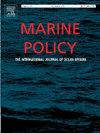在波斯湾实施有效的临时捕鱼禁令
IF 3.7
2区 社会学
Q2 ENVIRONMENTAL STUDIES
引用次数: 0
摘要
执行禁止所有捕鱼活动的捕鱼禁令是一项重要的渔业措施,旨在减少捕鱼压力和恢复枯竭的鱼类种群。过度捕捞与气候变化一起,对波斯湾(尤其是伊朗)鱼类生物多样性和渔民生计构成严重威胁。这项研究采用了自下而上的方法,以促进伊朗南部渔业社区与政府当局之间建立共识,最终导致在波斯湾北部通过了延长的捕鱼禁令。为了实现这一目标,通过分发和收集652份问卷进行了初步调查,以评估主要利益攸关方群体(包括渔民、伊朗渔业组织(IFO)和伊朗环境部(IDE)的官员以及科学专家)对该地区目前捕鱼死亡率水平的看法。随后,通过计算捕鱼禁令评分(FBS)指数来评估执行捕鱼禁令的最佳时机。FBS值是通过将捕获的40种商业上重要或优势鱼类(包括32种硬骨鱼、5种甲壳类、2种鲨鱼和1种头足类)的月度卵巢发育百分比、每种鱼类对渔业的加权重要性以及鱼类种群的现状乘以3个组成部分来计算的。调查结果显示,虽然大多数渔民对渔业共同管理不力表示担忧,但他们同样对该地区正在进行的鱼类捕捞感到担忧。春季,特别是5月份,FBS为38.20,被认为是实施捕捞禁令的最佳时机。最后,召开了一次利益相关者会议,与会者讨论了调查结果,并最终达成共识,从5月开始实施年度禁渔令。鉴于波斯湾鱼类资源的跨界性质,建议各邻国与伊朗合作,在整个区域采取协调一致和更有效的捕鱼禁令。本文章由计算机程序翻译,如有差异,请以英文原文为准。
Toward an effective temporary fishing ban law enforcement in the Persian Gulf
Implementing a fishing ban, which prohibits all fishing activities, is a significant fisheries measure aimed at reducing fishing pressure and restoring depleted fish populations. Overfishing, along with climate change, poses a serious threat to fish biodiversity and the livelihoods of fishers in the Persian Gulf, particularly in Iran. This study employed a bottom-up approach to facilitate consensus-building between the fishing communities in southern Iran and governmental authorities, ultimately leading to the adoption of an extended fishing ban in the northern Persian Gulf. To achieve this objective, an initial survey was conducted by distributiing and collectiing 652 questionnaires to evaluate the perceptions of key stakeholder groups— including fishers, officials from the Iranian Fisheries Organization (IFO) and the Iranian Department of Environment (IDE), as well as scientific experts— regarding current levels of fishing mortality in the region. Subsequently, the optimal timing for enforcing a fishing ban was assessed by computing the Fishing Ban Score (FBS) index. The FBS values were calculated by multiplying three componetns: the monthly ovarian development percentages of 40 commercially important or dominant fish species in the catch (including 32 teleosts, 5 crustaceans, 2 sharks, and 1 cephalopod), the weighted importance of each species to fisheries, and the current status of the fish stocks. The results revealed that while most fishermen expressed concerns about weak fisheries co-management, they were equally apprehensive about the ongoing exploitation of fish in the region. Spring—particularly May, with an FBS of 38.20—was identified as the optimal time for implementing the fishing ban. Finally, a stakeholder meeting was convened, during which participants discussed the findings and ultimately reached a consensus to implement an annual fishing ban commencing in May. Given the transboundary nature of fish stocks in the Persian Gulf, it is recommended that neighboring countries collaborate with Iran in adopting a coordinated and more effective fishing ban across the region.
求助全文
通过发布文献求助,成功后即可免费获取论文全文。
去求助
来源期刊

Marine Policy
Multiple-
CiteScore
7.60
自引率
13.20%
发文量
428
期刊介绍:
Marine Policy is the leading journal of ocean policy studies. It offers researchers, analysts and policy makers a unique combination of analyses in the principal social science disciplines relevant to the formulation of marine policy. Major articles are contributed by specialists in marine affairs, including marine economists and marine resource managers, political scientists, marine scientists, international lawyers, geographers and anthropologists. Drawing on their expertise and research, the journal covers: international, regional and national marine policies; institutional arrangements for the management and regulation of marine activities, including fisheries and shipping; conflict resolution; marine pollution and environment; conservation and use of marine resources. Regular features of Marine Policy include research reports, conference reports and reports on current developments to keep readers up-to-date with the latest developments and research in ocean affairs.
 求助内容:
求助内容: 应助结果提醒方式:
应助结果提醒方式:


